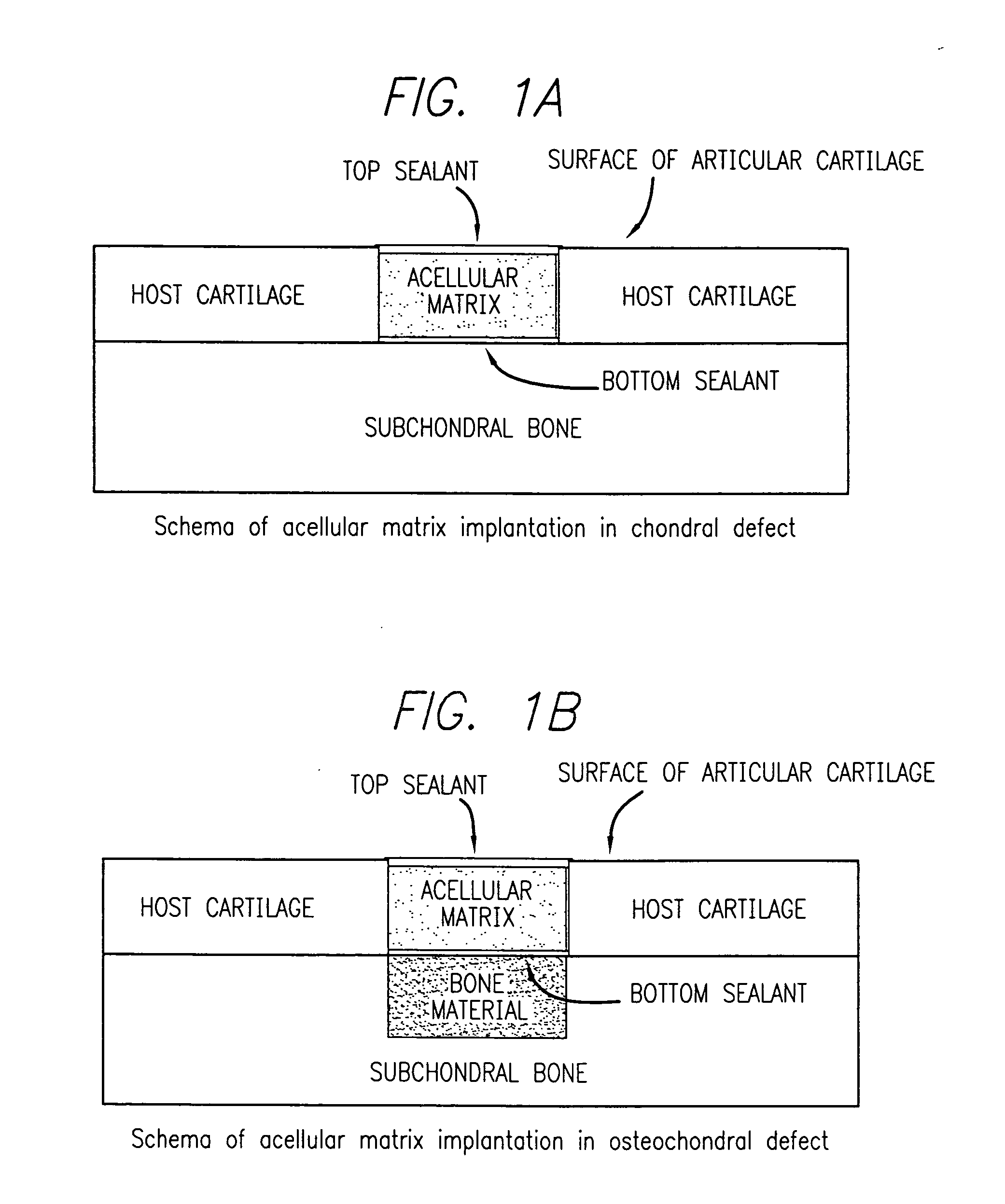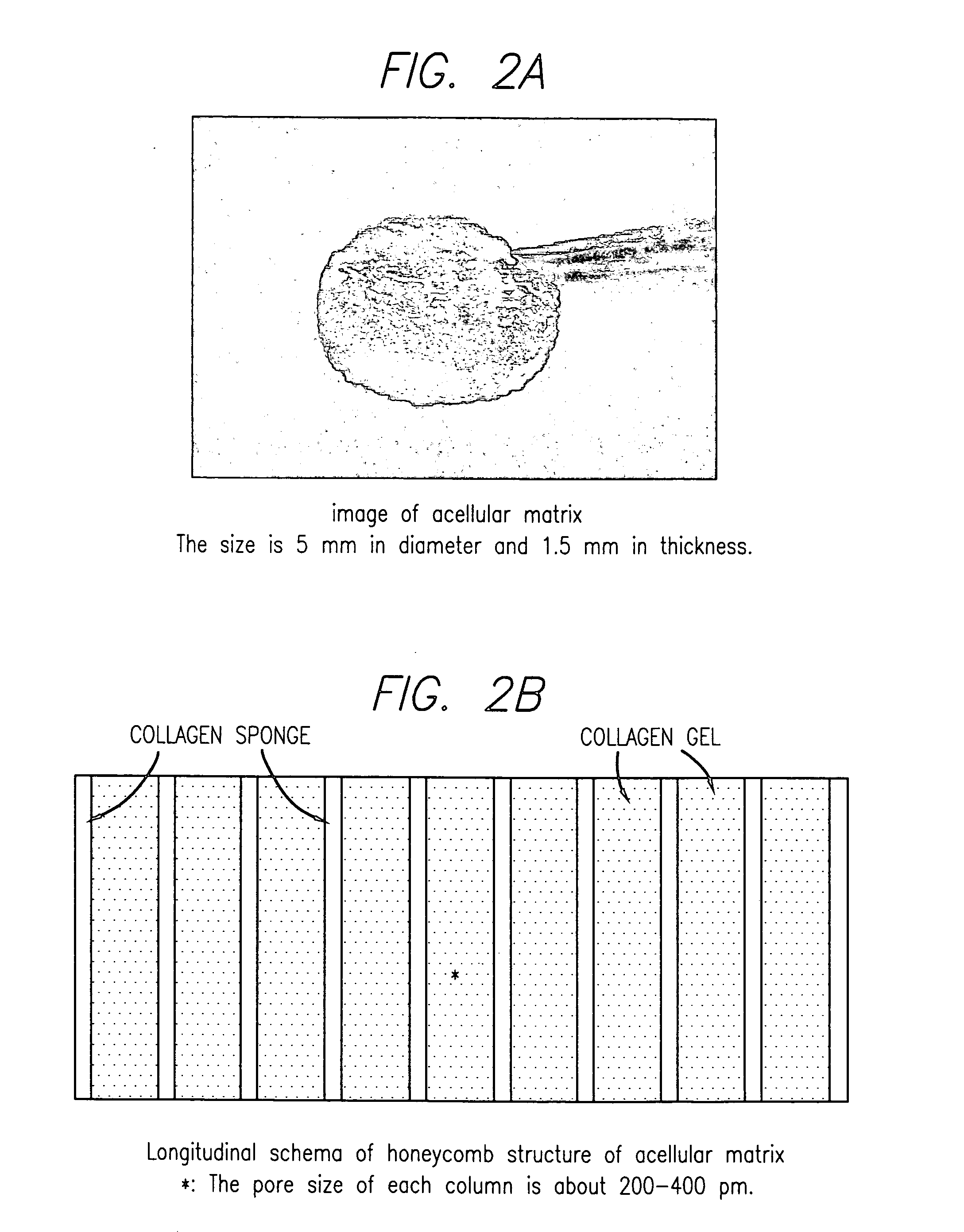Biocompatible tissue sealant for treatment of osteochondral and bone defects using an acellular matrix implant
a biocompatible tissue and bone technology, applied in the field of ace, can solve the problems of debilitating disability, affecting mobility, damage to the articular cartilage of active individuals and older generation adults,
- Summary
- Abstract
- Description
- Claims
- Application Information
AI Technical Summary
Benefits of technology
Problems solved by technology
Method used
Image
Examples
example 1
Preparation of Acellular Collagenous Implants
[0383] This example illustrates preparation of the acellular matrix implant.
[0384] 300 grams of a 1% aqueous atelocollagen solution (VITROGEN®), maintained at pH 3.0, is poured into a 10×20 cm tray. This tray is then placed in a 5 liter container. A 50 ml open container containing 30 ml of a 3% aqueous ammonia solution is then placed next to the tray, in the 5 liter chamber, containing 300 grams of said 1% aqueous solution of atelocollagen. The 5 liter container containing the open trays of atelocollagen and ammonia is then sealed and left to stand at room temperature for 12 hours. During this period the ammonia gas, released from the open container of aqueous ammonia and confined within the sealed 5 liter container, is reacted with the aqueous atelocollagen resulting in gelling said aqueous solution of atelocollagen.
[0385] The collagenous gel is then washed with water overnight and, subsequently, freeze-dried to yield a sponge like ma...
example 2
Biochemical and Histological Assays
[0391] This example describes assays used for biochemical and histological studies.
[0392] For biochemical (DMB) assay, the implant taken from the animal after certain time following the implantation, transferred to microcentrifuge tubes and digested in 300 μl of papain (125 μg / ml in 0.1 M sodium phosphate, 5 mM disodium EDTA, and 5 mM L-cysteine-HCl) for 18 hours at 60° C. S-GAG production in the implant is measured using a modified dimethylene blue (DMB) microassay with shark chondroitin sulfate as a control according to Connective Tissue Research, 9: 247-248 (1982).
[0393] DNA content is determined by Hoechst 33258 dye method according to Anal. Biochem., 174:168-176 (1988).
[0394] For histological assay, the remaining implants from each group were fixed in 4% paraformaldehyde. The implants were processed and embedded in paraffin. 10 μm sections were cut on a microtome and stained with Safranin-O (Saf O).
[0395] For immunohistochemistry, the sam...
example 3
Evaluation of Integration of Acellular Matrix Implant in a Swine Model
[0396] This example describe the procedure and results of study performed for evaluation of integration of porcine in a swine model.
[0397] An open arthrotomy of the right knee joint was performed on all animals, and a biopsy of the cartilage was obtained.
[0398] A defect was created in the medial femoral condyle of the pig's right knee. This defect (control) was not implanted with an acellular matrix implant but was left intact. Following surgery, the joint was immobilized with an external fixation implant for a period of about two weeks. Two weeks after the arthrotomy on the right knee was performed, an open arthrotomy was performed on the left knee and defects were created in this medial femoral condyle. The acellular matrix implant was implanted within the defect (s) in this knee which was similarly immobilized. The operated sites were subsequently viewed via arthroscopy two weeks after implantation or defect...
PUM
| Property | Measurement | Unit |
|---|---|---|
| bond strength | aaaaa | aaaaa |
| tensile strength | aaaaa | aaaaa |
| peel strengths | aaaaa | aaaaa |
Abstract
Description
Claims
Application Information
 Login to View More
Login to View More - R&D
- Intellectual Property
- Life Sciences
- Materials
- Tech Scout
- Unparalleled Data Quality
- Higher Quality Content
- 60% Fewer Hallucinations
Browse by: Latest US Patents, China's latest patents, Technical Efficacy Thesaurus, Application Domain, Technology Topic, Popular Technical Reports.
© 2025 PatSnap. All rights reserved.Legal|Privacy policy|Modern Slavery Act Transparency Statement|Sitemap|About US| Contact US: help@patsnap.com



